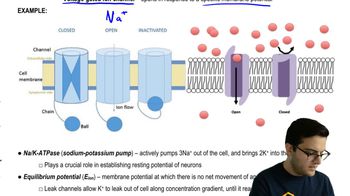The activation of receptor tyrosine kinases is characterized by
a. Dimerization and phosphorylation
b. Dimerization and IP3 binding.
c. A phosphorylation cascade
d. GTP hydrolysis
 Verified step by step guidance
Verified step by step guidance



The activation of receptor tyrosine kinases is characterized by
a. Dimerization and phosphorylation
b. Dimerization and IP3 binding.
c. A phosphorylation cascade
d. GTP hydrolysis
Lipid-soluble signaling molecules, such as aldosterone, cross the membranes of all cells but affect only target cells because
a. Only target cells retain the appropriate DNA segments.
b. Intracellular receptors are present only in target cells.
c. Only target cells have enzymes that break down aldosterone.
d. Only in target cells is aldosterone able to initiate the phosphorylation cascade that turns genes on.
Consider this pathway: epinephrine → G protein-coupled receptor → G protein → adenylyl cyclase → cAMP. Identify the second messenger.
a. cAMP
b. G protein
c. GTP
d. Adenylyl cyclase